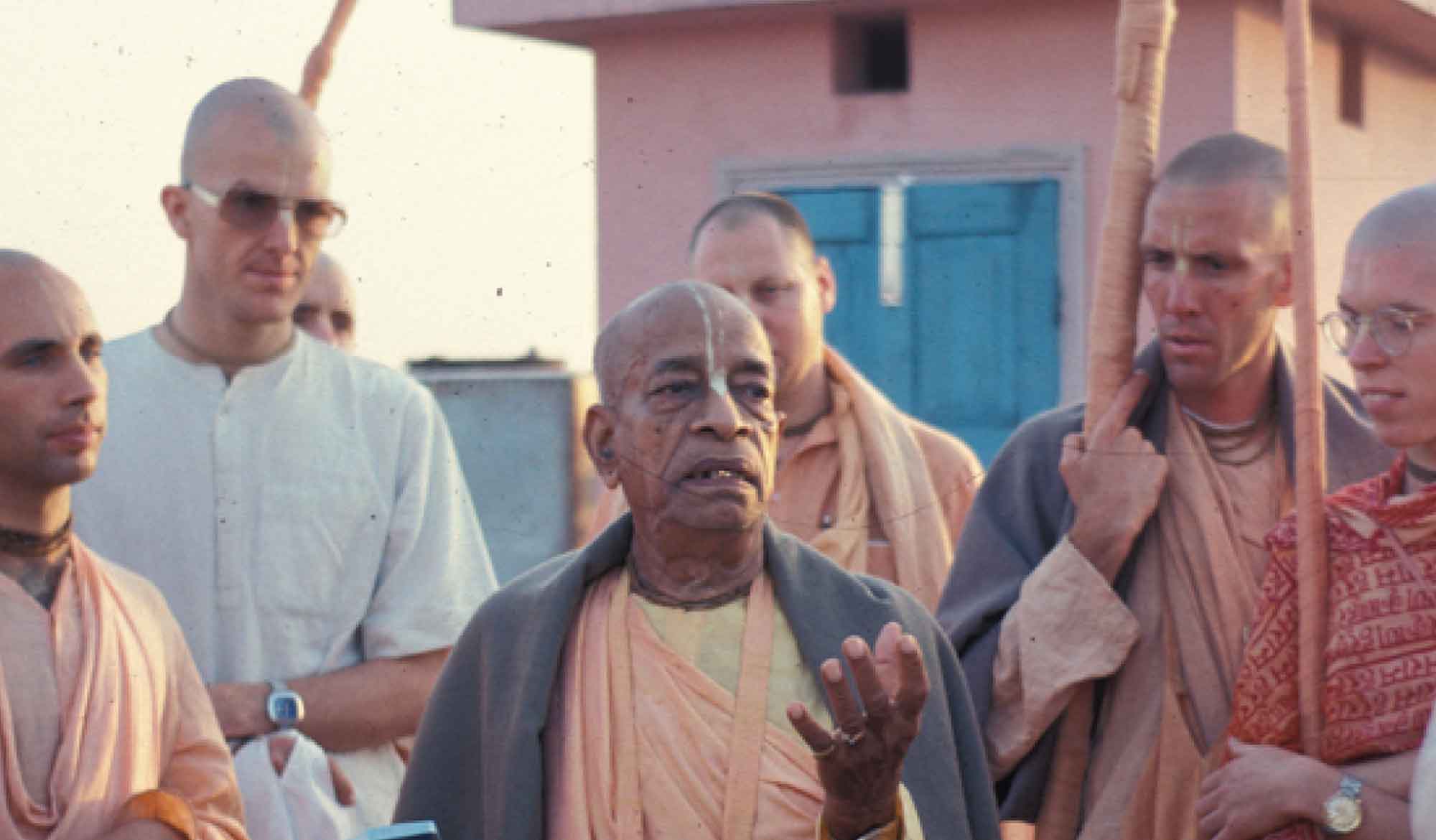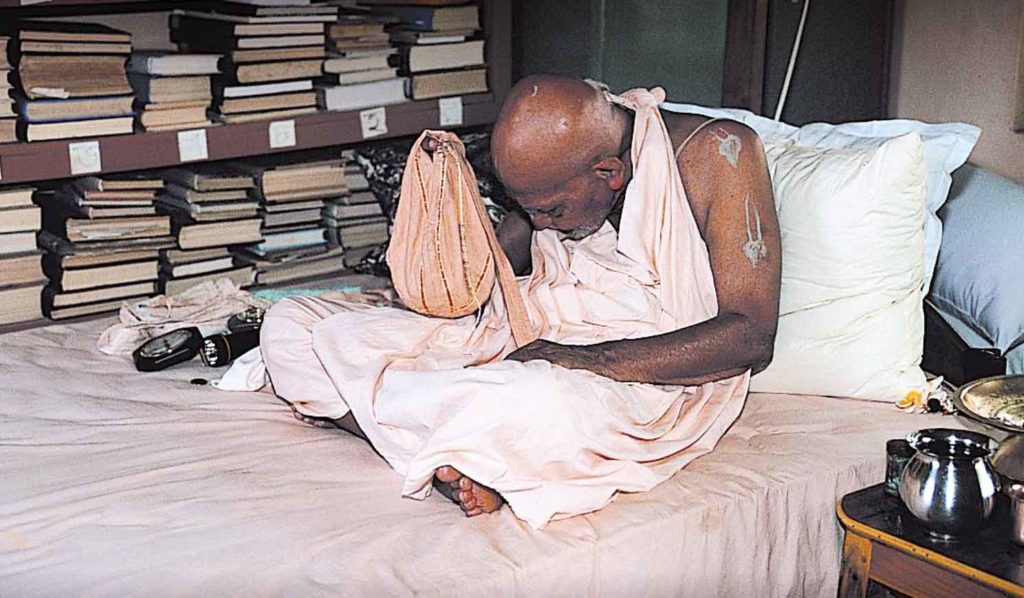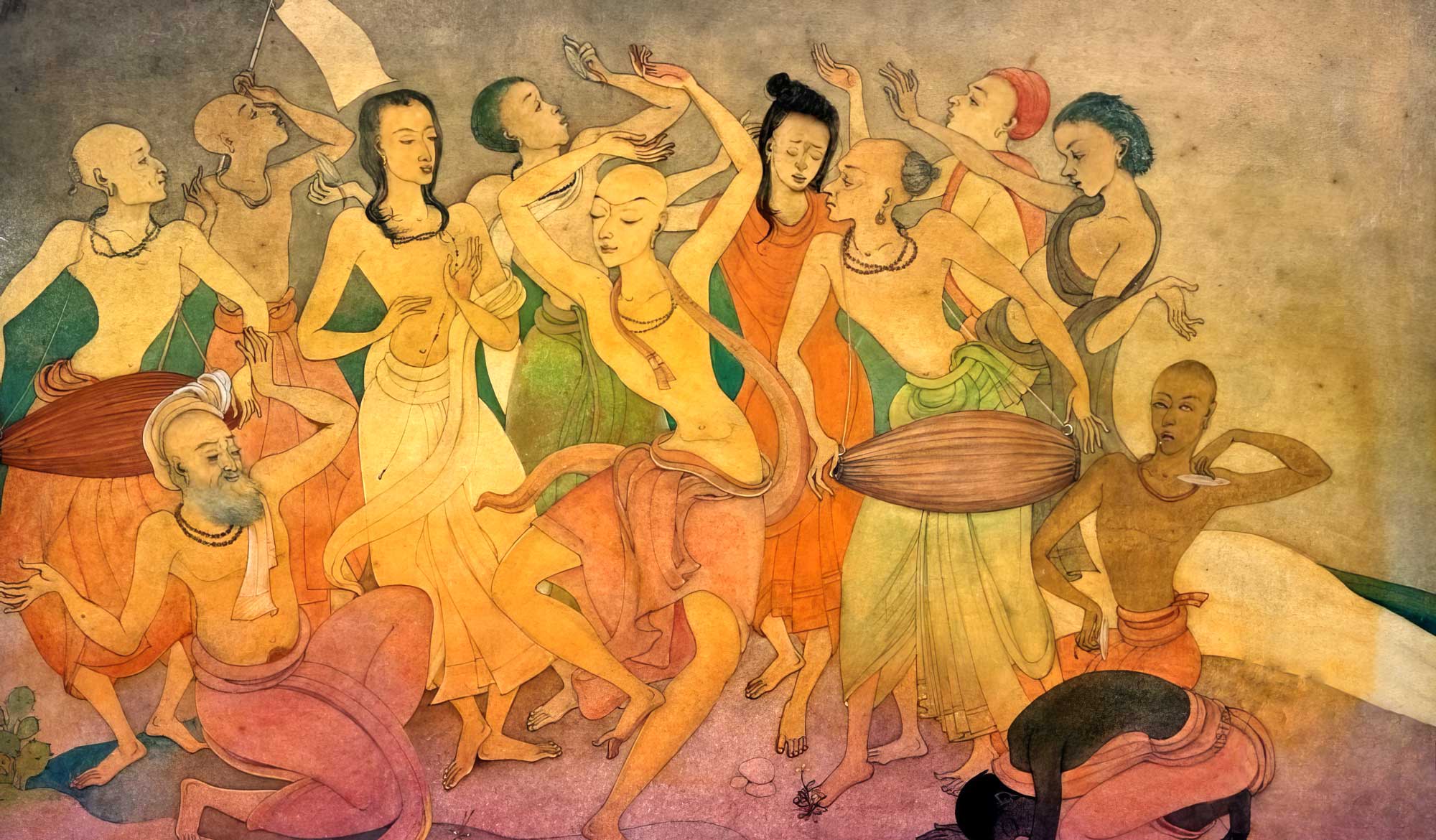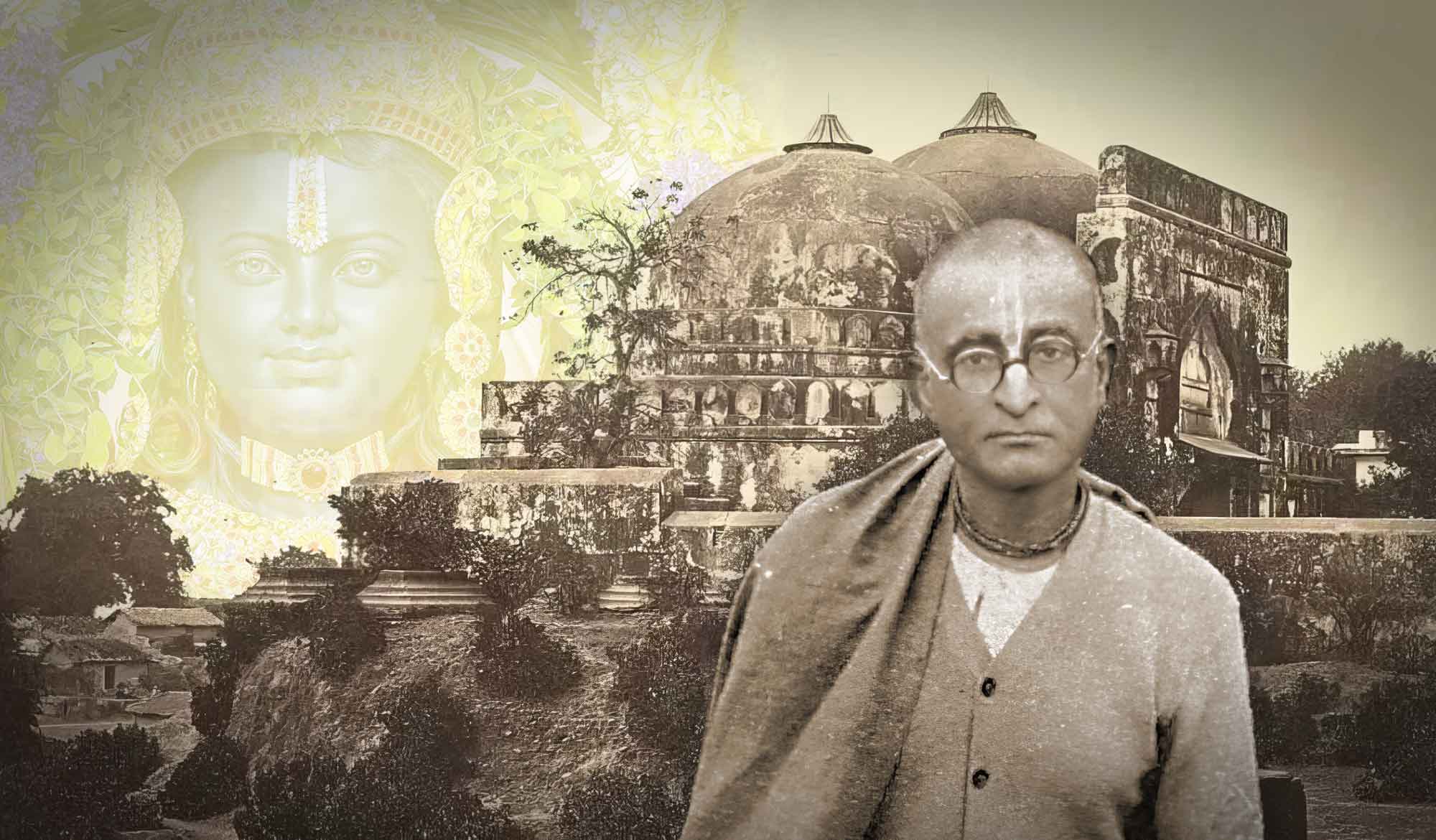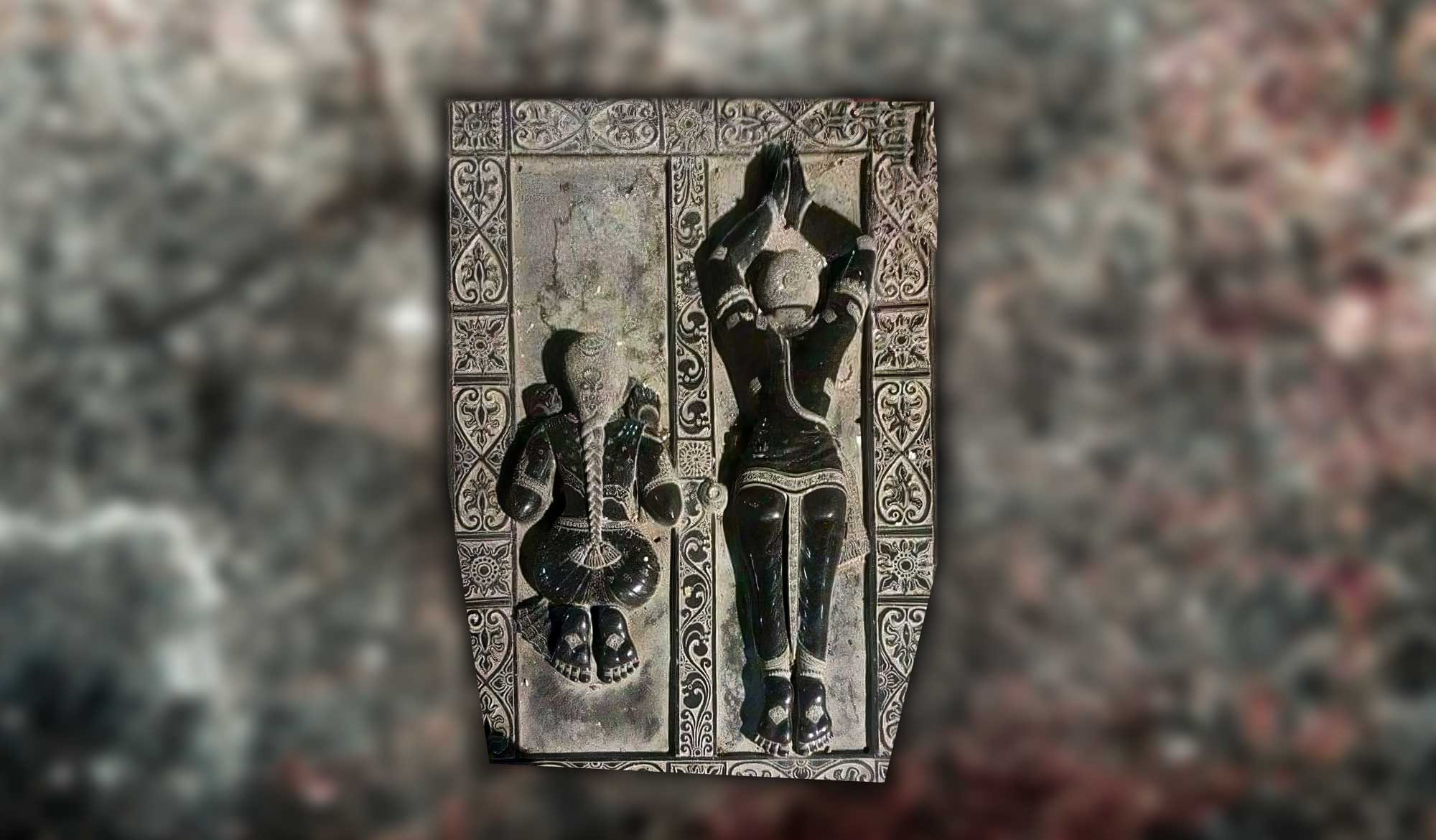Overview
“How Great is Śrīla Prabhupāda?” is an article adapted from a lecture given by Śrīla B.G.Narasiṅgha Mahārāja on Śrīla Prabhupāda’s appearance day on September 1st, 2002. In this article, Narasiṅgha Mahārāja expounds the greatness of Śrīla Prabhupāda and his phenomenal achievements.
If we enter the ocean by boat, we can navigate our direction to a destination based on the stars. The stars are compared to the knowledge found in the Vedas. One of those stars in the sky is called Dhruva-loka. In modern science, Dhruva-loka is called the Pole Star. When we are in the ocean, if we lose sight of that star then we cannot benefit from all the other stars – we will be lost in the ocean. The Pole Star doesn’t move. It is fixed in one place.
Śrī Guru may be compared to the Pole Star, because with the help of the guru, we can derive great benefit from Vedic knowledge. But without the help of the spiritual master, we will be bewildered in our attempt.
The Vedas are sometimes compared to a ‘jungle of knowledge’ – not just an ordinary jungle, but a very dense jungle. In this material world we are already in the jungle of material misconceptions and if we want to search for God then we must come out of this jungle. To fulfil our search we may enter into the study of the Vedas. But if we study the Vedas without the help of the guru, we may eventually conclude that there is no God. Or we may conclude that there are many Gods. Or worst of all, we may conclude that, “I am God. We are all God”. In this way, without the help of the guru, we may become bewildered and meet with ultimate ruin.
In the Vedic literature there are various opinions. In the Viṣṇu Purāṇa it says that Viṣṇu is Supreme. In the Śiva Purāṇa it says Śiva is the Supreme. In the Mārkaṇ∂eya Purāṇa it says that Durgā is Supreme. And in the Upaniṣads it is mentioned, ahaṁ brahmāsmi – ‘I am Brahman’. So one may think that there are many gods, or that there are so many gods that there is no God at all. We may think that what the Vedas say cannot be true because there are too many apparent contradictions. Or we may take ahaṁ brahmāsmi as the ultimate conclusion and then believe that we are all God. This is what happens to persons who study the Vedas without the help of a bona-fide guru.
Śrīla Vyāsadeva compiled the Vedas in four divisions – the Atharva Veda, Sāma Veda, Ṛg Veda and the Yajur Veda. Then he compiled the Purāṇas and other literatures. Lastly, he wrote the Vedānta-sūtras. Vedānta means the end of knowledge. After revealing so much knowledge, Vyāsadeva tried to bring his writing to an end, to the conclusion of knowledge. After he completed the Vedānta-sūtras however, Vyāsa still did not feel satisfied. He was not satisfied within himself – his mind was troubled. He crossed the ocean of knowledge but still he was unsatisfied.
Then Nārada Muni, the guru of Vyāsadeva, came and Vyāsadeva inquired from him as to why he did not feel satisfied. Nārada Muni said, “Actually you are a cheater. You have cheated the people of the world because you have only indirectly described the truth. Without directly describing the līlā of Kṛṣṇa, the Supreme Personality of Godhead, you have not done justice to the truth. Now you have to give the meaning of all these things in one book.” Then Vyāsadeva wrote the Bhāgavata Purāṇa, the Śrīmad Bhāgavatam.
Bhāgavatam is the natural commentary on the Vedānta-sūtras. The message of the Bhāgavatam is summarised in the First Canto – kṛṣṇas tu bhagavān svayam. Of all the Devas and incarnations of the Supreme Lord, Kṛṣṇa is the Supreme and original Godhead. Vyāsadeva revealed in the Bhāgavatam that Kṛṣṇa is the āśraya-tattva. In other Vedic literatures, Vyāsadeva only revealed the āśraya-tattva. in part, not in full. If you are a ghost, then Śiva, who is known as Bhūtanātha, is your āśraya (shelter). Śiva stays in the cremation grounds and he gives shelter to so many ghosts. If you are a materialist, then Durgā is your āśraya. If you are a materialist then you get everything from this material nature by the grace of Durgā. But when we are ready for the perfection of life, Vyāsadeva revealed that Nārāyaṇa is the āśraya-tattva, because Nārāyaṇa resides in Vaikuṇṭha, which is above the material world and everything is under His shelter.
In the Śrīmad Bhāgavatam, Vyāsa revealed that the highest plane is called Goloka. If we journey to the highest place in Vaikuṇṭha and look towards the spiritual sky, from there we will see a land known as Goloka Vṛndāvana. Goloka Vṛndāvana is above Vaikuṇṭha and in that place Śrī Śrī Rādhā-Kṛṣṇa are Supreme.
Kṛṣṇa resides eternally in Goloka Vṛndāvana, giving shelter to all His devotees. Vyāsadeva therefore described that the lotus feet of Kṛṣṇa are the Supreme shelter of all living beings. Kṛṣṇa confirms this also – jīva bhūta sanātana. Kṛṣṇa says in the Bhagavad-gītā that all these jīvas have come from Him. All living beings are His parts and parcels. He is their ultimate shelter.
So the dear-most representative of Kṛṣṇa comes to the world to represent this message of Vyāsadeva -Kṛṣṇa is the Supreme Personality of Godhead. There have been many gurus in the world since the time of Vyāsadeva, but all of them did not represent the ultimate conclusion. Someone may ask, “Is there anything special about your Prabhupāda, your guru?” Naturally we will say, “Oh, of course, there are many special things about my guru.” Even if our guru never left the village in which he was born, still we will think that our guru has many special qualities. And if we are asked, we will say, “My guru saved me from the ocean of ignorance. That is the special quality that makes our guru different from all others and especially dear to us.”
oṁ ajñāna-trimirāndhasya jñānāñjana-śalākaya
cakṣur unmīlitaṁ yena tasmai śrī-gurave nama˙
“I offer respects unto Śrī Guru who opened my eyes, that were covered with the darkness of ignorance with the salve of divine knowledge.”
Without guru, our eyes are sealed in darkness. We are born into darkness, into ignorance, but our guru opens our eyes with the torchlight of knowledge. This is a common aspect found in the relationship between all bona-fide gurus and bona-fide disciples.
But about our Guru Mahārāja, Śrīla A.C. Bhaktivedānta Swami Prabhupāda, we must say that there is a special characteristic found in him that is very rare, and to this day we have not seen it duplicated. What is that characteristic? It is something that was previously only known in the most cultured spiritual sections of Indian society. He took that out of India and distributed that to every town and village in the whole world.
pṛthīvite āche yata nagarādi grāma
sarvatra pracāra haibe mora nāma
“In every town and village of the world, My Holy Name will be sung.” (Caitanya-bhāgavata, Antya-khaṇḍa 4.126)
This is the prediction of Śrī Caitanya Mahāprabhu, that the Holy Name of Kṛṣṇa will be spread in every town and village. By the mercy and instruction of Śrīla Prabhupāda, the Holy Name of Kṛṣṇa was spread all over the world. From faraway places in the north such as Siberia and deep into the southern reaches of Africa and Australia, to China in the Far East and throughout the western world – the Holy Name and the worship of Rādhā-Kṛṣṇa was carried everywhere under the guidance of Śrīla Prabhupāda.
A guru, or a great ācārya, may spread Kṛṣṇa Consciousness in a village or even in a state or a country, but to spread Kṛṣṇa consciousness throughout the whole world, that indeed is very rare. For example, Rāmānujācārya, a great Vaiṣṇava saint, spread viṣṇu-bhakti in Tamil Nadu, Karnataka and Andhra Pradesh. Rāmānuja is considered to be the śakti of Ananta – still when he preached in Kerala they did not accept and they told him to leave. Who can speak better than Ananta, who has a thousand mouths and knows all the Vedas? But even so, Rāmānuja was not successful in Kerala.
There is a place called Tonnur in Karnataka where Rāmānuja debated with sixty-thousand Jain philosophers and defeated them. At that time Ananta personally manifested through Rāmānuja and defeated and converted the Jains. If you visit the Yoga-Narasiṁha temple in Tonnur, you will see a deity of Rāmānuja and behind him is Ananta. The sthala-purāṇa there says that Lord Ananta Himself came there and, with many mouths, debated with the Jain scholars and defeated them all. So Rāmānuja was indeed a very great personality, yet he could only spread his mission successfully in three states, Tamil Nadu, Karnataka and Andhra Pradesh.
Another very great saint in India was Madhvācārya. He is considered to have been an avatāra of Bhīma and Vāyu. But he was only able to spread his mission successfully in Karnataka. Practically speaking, outside of Karnataka nobody has heard of Madhvācārya. Of course, on occasion he preached in Vārāṇasī, but the people of Vārāṇasī never became the followers of Madhvācārya. Vārāṇasī remained what it had always been, a place of Māyāvādī philosophers.
Both Rāmānuja and Madhvācārya were indeed very great personalities, but their spiritual inf luence was more or less regional. However, in the time of Śrīla Prabhupāda, he not only had an inf luence in a few states in India but he travelled around the world twelve times and successfully spread his mission. Because of his preaching, the name of Kṛṣṇa and Vaiṣṇavism is known in almost every country in the world. With this consideration we may ask, “How great is Śrīla Prabhupāda?”
When the mission of Rāmānuja, who held the śakti of Ananta, was successful in only three states and the mission of Madhvācārya, who is Bhīma and Vāyu combined, was successful in only one state then what is the power and greatness of that person who spread Kṛṣṇa Consciousness throughout the whole world? How great is Śrīla Prabhupāda?
When Rāmānuja and Madhvācārya toured India for spreading their missions, they had to contend with the opposing elements of Hinduism, Buddhism, Islam, the materialists and the Māyāvādīs. But when Śrīla Prabhupāda went out into the world to spread Kṛṣṇa consciousness, he had to contend with all of the above and more. The scientists, who hold a grip on the whole world, were especially a formidable opposition to Kṛṣṇa consciousness, but Śrīla Prabhupāda defeated them and many of them surrendered and became his disciples.
Śrīla Prabhupāda had to fight with many opposing elements in countries where the culture was not at all favourable for spiritual advancement in Kṛṣṇa consciousness. Yet he established over one hundred temples, āśramas, and Kṛṣṇa conscious communities throughout the world.
With our mind we might try to imagine who he was, what power stood behind him and what his eternal spiritual identity is. Some of the greatest Vaiṣṇavas I have ever had the good fortune to meet considered that Śrīla Prabhupāda was the śakti of Nityānanda-Baladeva.
Rāmānuja held the śakti of Ananta, but Ananta is an aṁśa of Baladeva. Aṁśa means a part – Baladeva is the source of Ananta. Baladeva means the full spiritual potency and energy of Godhead. In gaura-līlā, Nityānanda Prabhu and Baladeva are considered non-different. Many great transcendentalists in our times who witnessed what our Guru Mahārāja achieved, have concluded that he was the śakti of Nityānanda Prabhu, a śaktyāveśa-avatāra. That means that he was empowered with the śakti of Śrī Nityānanda Prabhu to spread Kṛṣṇa consciousness throughout the world.
Nowadays we may meet a swami or guru (especially in India) who has many disciples and when asked, “Who are you?” he will say, “I am Bhagavān, I am God!” or he may say, “I am the jagat-guru (the spiritual master of the universe).” But when our Guru Mahārāja, Śrīla Prabhupāda was asked “Who are you?” he would say, “I am the humble servant of my Gurudeva. My only credit is that I am the obedient servant to the order of my guru. All the success that I have is due to the grace of my guru.”
Although it is the opinion of many great devotees that our Guru Mahārāja was a śaktyāveśa-avatāra of Nityānanda Prabhu, still in his own words, he considered himself to be the humble servant of his guru. Our Guru Mahārāja had such a vision that he could see that the whole world could become God conscious, Kṛṣṇa conscious, but he still considered himself the humble servant of his guru.
If we have love for someone then we may naturally exaggerate their qualities, because that is the natural way of love. But even without any exaggeration due to love for our Guru Mahārāja, if we say that Śrīla Prabhupāda was one of the greatest saints to have ever come to this Earth, it cannot be taken as an exaggeration – his life and achievements stand as evidence for his greatness.
Related Articles
- 📖 Prabhupāda Vijaya (Book)
- My Guru is Rādhārāṇī by Śrīla Bhakti Gaurava Narasiṅgha Mahārāja
- Become Guru! by Śrīla Bhakti Gaurava Narasiṅgha Mahārāja
- Purport to Śrīla Prabhupāda-līlā Smaraṇa-Maṅgala Stotram by Śrīla Bhakti Gaurava Narasiṅgha Mahārāja
- Mahāprabhu as Prabhupāda by Śrīla Bhakti Gaurava Narasiṅgha Mahārāja
- How Great is Śrīla Prabhupāda? by Śrīla Bhakti Gaurava Narasiṅgha Mahārāja
- A Few Words on the Rasa of Śrīla Prabhupāda and the ‘Suicide Squad’ by Śrīla Bhakti Gaurava Narasiṅgha Mahārāja
- The Prākṛta and Aprākṛta-līlā of Śrī Guru by Śrīla Bhakti Gaurava Narasiṅgha Mahārāja
- The Golden Age of the Saṅkīrtana Movement by Śrīla Bhakti Gaurava Narasiṅgha Mahārāja
- Bhaktivedānta by Śrīla Bhakti Gaurava Narasiṅgha Mahārāja
- The Disappearance of a Śaktyāveśa-avatāra by Śrīla Bhakti Gaurava Narasiṅgha Mahārāja
- Śrīla Prabhupāda – A Second Generation Devotee’s Perspective by Gaura Gopāla Dāsa
Pilgrimage with Swami Narasiṅgha – Part 7: Keśī Ghāṭa
Continuing with our pilgrimage series, this week Śrīla Narasiṅgha Mahārāja takes us to Keśī Ghāṭā where he tells us about Madhumaṅgala’s meeting with the Keśī demon, what Keśī represents, and how Śrīla Prabhupāda almost acquired Keśī Ghāṭa. Mahārāja also narrates his own experience. This article has been adapted from a number of talks and articles by Narasiṅgha Mahārāja.
Prema Dhāma Deva Stotram with the Narasiṅgha Sevaka Commentary – Verses 61-65
In verses 61 to 65 of 'Prema Dhāma Deva Stotram', Śrīla Śrīdhara Mahārāja narrates the pastime of Śrī Caitanya at Caṭaka Parvata In Purī and explains how the scriptures produced by Brahmā and Śiva are ultimately searching for the personality of Mahāprabhu who is merciful too all jīvas, no matter what their social position.
Prabhupāda Śrīla Sarasvatī Ṭhākura’s Visit to Ayodhyā
With the forthcoming observance of Śrī Rāma Navamī, we present 'Prabhupāda Śrīla Sarasvatī Ṭhākura’s Visit to Ayodhyā' written by Śrīla Bhaktisiddhānta Sarasvatī Ṭhākura Prabhupāda from The Gaudīyā magazine, Vol 3. Issue 21/ In December 1924, after visiting Benares and Prāyāga, Sarasvatī Ṭhākura visited the birth-site of Śrī Rāmācandra in Ayodhyā.
Śaraṇāgati – The Only Path to Auspiciousness
In this article, 'Śaraṇāgati - The Only Path to Auspiciousness', Dhīra Lalitā Dāsī analyses the process of śaraṇāgati (surrender) beginning with śraddhā (faith). She also discusses the role of śāstra and the Vaiṣṇava in connection with surrender.
Pilgrimage with Swami Narasiṅgha – Part 7: Keśī Ghāṭa
Continuing with our pilgrimage series, this week Śrīla Narasiṅgha Mahārāja takes us to Keśī Ghāṭā where he tells us about Madhumaṅgala’s meeting with the Keśī demon, what Keśī represents, and how Śrīla Prabhupāda almost acquired Keśī Ghāṭa. Mahārāja also narrates his own experience. This article has been adapted from a number of talks and articles by Narasiṅgha Mahārāja.
Prema Dhāma Deva Stotram with the Narasiṅgha Sevaka Commentary – Verses 61-65
In verses 61 to 65 of 'Prema Dhāma Deva Stotram', Śrīla Śrīdhara Mahārāja narrates the pastime of Śrī Caitanya at Caṭaka Parvata In Purī and explains how the scriptures produced by Brahmā and Śiva are ultimately searching for the personality of Mahāprabhu who is merciful too all jīvas, no matter what their social position.
Prabhupāda Śrīla Sarasvatī Ṭhākura’s Visit to Ayodhyā
With the forthcoming observance of Śrī Rāma Navamī, we present 'Prabhupāda Śrīla Sarasvatī Ṭhākura’s Visit to Ayodhyā' written by Śrīla Bhaktisiddhānta Sarasvatī Ṭhākura Prabhupāda from The Gaudīyā magazine, Vol 3. Issue 21/ In December 1924, after visiting Benares and Prāyāga, Sarasvatī Ṭhākura visited the birth-site of Śrī Rāmācandra in Ayodhyā.
Śaraṇāgati – The Only Path to Auspiciousness
In this article, 'Śaraṇāgati - The Only Path to Auspiciousness', Dhīra Lalitā Dāsī analyses the process of śaraṇāgati (surrender) beginning with śraddhā (faith). She also discusses the role of śāstra and the Vaiṣṇava in connection with surrender.


